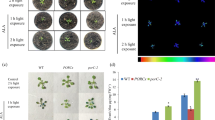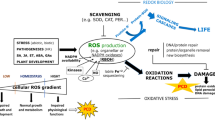Abstract
In this paper we provide evidence for involvement of chloroplast as alternate organelle for initiating PCD in plants under light and abiotic stress. In animals, mitochondria are the major source of reactive oxygen species (ROS) and key executioner of programmed cell death (PCD). In plants, however, the primary site of generation of ROS is chloroplast and yet its involvement in PCD has not been worked out in details. We found by Evans blue staining that salt (150 mM NaCl)-treated protoplasts obtained from green seedlings had higher rate of cell death than protoplasts obtained from etiolated seedlings. This indicated that cell death induced by NaCl is accentuated by light. Imposition of salt-stress to green protoplasts generated H2O2. Known hallmarks of PCD i.e., blebbing of cell membrane, loabing in nucleus, nick in DNA were observed in light-exposed salt-treated protoplasts and seedlings. TUNEL-FACS assay demonstrate several DNA nicks in the salt-treated green protoplasts exposed to light. Conversely, salt-treated etiolated protoplasts kept in dark had only a few TUNEL-positive nuclei. Similarly, a substantial numbers of TUNEL positive nuclei were observed in green seedlings due to salt treatment in light. However, salt-treated etiolated seedlings kept in dark had very few TUNEL positive nuclei. Addition of Caspase 3 inhibitor (DAVD-CHO) rescued (~50 %) green protoplasts from salt-stress induced cell death suggesting an involvement of apoptosis like PCD (AL-PCD). Ultra structure studies of chloroplast, mitochondria and nucleus from the leaves obtained from salt treated seedlings at the time point that showed PCD signature, resulted to severe granal de-stacking in chloroplasts while structural integrity of mitochondria was maintained. These studies demonstrate the photo-modulation of salinity-induced PCD in photosynthetic tissues is mainly executed by chloroplasts.













Similar content being viewed by others
References
Lockshin RA, Zakeri Z (2004) Apoptosis, autophagy, and more. Int J Biochem Cell Biol 36:2405–2419
Buss RR, Sun W, Oppenheim RW (2006) Adaptive roles of programmed cell death during nervous system development. Annu Rev Neurosci 29:1–35
Lam E (2008) Programmed cell death in plants: orchestrating an intrinsic suicide program within walls. Crit Rev Plant Sci 27:413–423
Fath A, Bethke P, Lonsdale J, Meza-Romero R, Jones R (2000) Programmed cell death in cereal aleurone. Plant Mol Biol 44:255–266
Drew MC, He CJ, Morgan PW (2000) Programmed cell death and aerenchyma formation in roots. Trends Plant Sci 5:123–127
Mittler R (2002) Oxidative stress, antioxidants and stress tolerance. Trends Plant Sci 7:405–410
Hoeberichts FA, Woltering EJ (2003) Multiple mediators of plant programmed cell death: interplay of conserved cell death mechanisms and plant-specific regulators. Bioessays 25:47–57
Li J, Jiang A, Chen H, Wang Y, Zhang WPB (2007b) Lanthanum prevents salt stress-induced programmed cell death in rice root tip cells by controlling early induction events. J Integr Biol 49:1024–1031
Li J, Jiang A, Zhang W (2007a) Salt stress-induced programmed cell death in rice root tip cells. J Integr Plant Biol 49:481–486
Zuppini A, Andreoli C, Baldan B (2007) Heat stress: an inducer of programmed cell death in Chlorella saccharophila. Plant Cell Physiol 48:1000–1009
Yamada T, Ichimura K, Kanekatsu M, van Doorn WG (2009) Homologs of genes associated with programmed cell death in animal cells are differentially expressed during senescence of Ipomoea nil petals. Plant Cell Physiol 50:610–625
Affenzeller MJ, Darehshouri A, Andosch A, Lutz C, Lutz-Meindl U (2009) Salt stress-induced cell death in the unicellular green alga Micrasterias denticulata. J Exp Bot 60:939–954
Bollhoner B, Prestele J, Tuominen H (2012) Xylem cell death: emerging understanding of regulation and function. J Exp Bot 63:1081–1094
Chaves MM, Flexas J, Pinheiro C (2009) Photosynthesis under drought and salt stress: regulation mechanisms from whole plant to cell. Ann Bot 103:551–560
Oosawa N, Masuda T, Awai K et al (2000) Identification and light-induced expression of a novel gene of NADPH-protochlorophyllide oxidoreductase isoform in Arabidopsis thaliana. FEBS Lett 474:133–136
Pattanayak GK, Tripathy BC (2011) Overexpression of protochlorophyllide oxidoreductase C regulates oxidative stress in Arabidopsis. PLoS One 6:e26532
Chakraborty N, Tripathy BC (1992) Involvement of singlet oxygen in 5-aminolevulinic acid-induced photodynamic damage of cucumber (Cucumis sativus L.) chloroplasts. Plant Physiol 98:7–11
Tripathy BC, Chakraborty N (1991) 5-aminolevulinic acid induced photodynamic damage of the photosynthetic electron transport chain of cucumber (Cucumis sativus L.) cotyledons. Plant Physiol 96:761–767
Ferri KF, Kroemer G (2001) Mitochondria–the suicide organelles. Bioessays 23:111–115
Murphy MP (2009) How mitochondria produce reactive oxygen species. Biochem J 417:1–13
Rhoads DM, Umbach AL, Subbaiah CC, Siedow JN (2006) Mitochondrial reactive oxygen species. Contribution to oxidative stress and interorganellar signaling. Plant Physiol 141:357–366
Gill SS, Tuteja N (2010) Reactive oxygen species and antioxidant machinery in abiotic stress tolerance in crop plants. Plant Physiol Biochem 48:909–930
Gu ZT, Li L, Wu F et al (2015) Heat stress induced apoptosis is triggered by transcription-independent p53, Ca(2+) dyshomeostasis and the subsequent Bax mitochondrial translocation. Sci Reports 5:11497
Balk J, Leaver CJ, McCabe PF (1999) Translocation of cytochrome c from the mitochondria to the cytosol occurs during heat-induced programmed cell death in cucumber plants. FEBS Lett 463:151–154
Tiwari BS, Belenghi B, Levine A (2002) Oxidative stress increased respiration and generation of reactive oxygen species, resulting in ATP depletion, opening of mitochondrial permeability transition, and programmed cell death. Plant Physiol 128:1271–1281
Samuilov VD, Lagunova EM, Dzyubinskaya EV, Izyumov DS, Kiselevsky DB, Makarova YV (2002) Involvement of chloroplasts in the programmed death of plant cells. BioChemistry 67:627–634
Samuilov VD, Lagunova EM, Kiselevsky DB, Dzyubinskaya EV, Makarova YV, Gusev MV (2003) Participation of chloroplasts in plant apoptosis. Biosci Rep 23:103–117
Kim C, Meskauskiene R, Zhang S et al (2012) Chloroplasts of Arabidopsis are the source and a primary target of a plant-specific programmed cell death signaling pathway. Plant Cell 24:3026–3039
Doyle SM, Diamond M, McCabe PF (2010) Chloroplast and reactive oxygen species involvement in apoptotic-like programmed cell death in Arabidopsis suspension cultures. J Exp Bot 61:473–482
Brouwer B, Ziolkowska A, Bagard M, Keech O, Gardestrom P (2012) The impact of light intensity on shade-induced leaf senescence. Plant Cell Environ 35:1084–1098
De La Mata L, Caballo P, De La Haba P, Aguera E (2013) Study of the senescence process in primary leaves of sunflower (Helianthus annuus L.) plants under two different light intensities. Photosynthetica 51:85–94
Lutts S, Kinnet J, Bouharmont J (1996) NaCl-induced senescence in leaves of rice (Oryza sativa L.) cultivars differing in salinity resistance. Ann Bot 78:389–398
Uzelac B, Janosevic D, Budimir S (2008) In situ detection of programmed cell death in Nicotiana tabacum leaves during senescence. J Microsc 230:1–3
Carrion CA, Costa ML, Martinez DE, Mohr C, Humbeck K, Guiamet JJ (2013) In vivo inhibition of cysteine proteases provides evidence for the involvement of ‘senescence-associated vacuoles’ in chloroplast protein degradation during dark-induced senescence of tobacco leaves. J Exp Bot 64:4967–4980
Schelbert S, Aubry S, Burla B et al (2009) Pheophytin pheophorbide hydrolase (pheophytinase) is involved in chlorophyll breakdown during leaf senescence in Arabidopsis. Plant Cell 21:767–785
Asada K (2006) Production and scavenging of reactive oxygen species in chloroplasts and their functions. Plant Physiol 141:391–396
Zurbriggen MD, Carrillo N, Hajirezaei MR (2010) ROS signaling in the hypersensitive response: when, where and what for? Plant Signal Behav 5:393–396
Kumar S (2007) Caspase function in programmed cell death. Cell Death Differ 14:32–43
Watanabe N, Lam E (2011) Arabidopsis metacaspase 2d is a positive mediator of cell death induced during biotic and abiotic stresses. Plant J 66:969–982
del Pozo O, Lam E (1998) Caspases and programmed cell death in the hypersensitive response of plants to pathogens. Curr Biol 8:1129–1132
Gossett DR, Banks SW, Millhollon EP, Lucas MC (1996) Antioxidant response to NaCl stress in a control and an NaCl-tolerant cotton cell line grown in the presence of paraquat, buthionine sulfoximine, and exogenous glutathione. Plant Physiol 112:803–809
Turan S, Tripathy BC (2015) Salt-stress induced modulation of chlorophyll biosynthesis during de-etiolation of rice seedlings. Physiol Plant 153:477–491
Dalal VK, Tripathy BC (2012) Modulation of chlorophyll biosynthesis by water stress in rice seedlings during chloroplast biogenesis. Plant Cell Environ 35:1685–1703
Lin J, Wang Y, Wang G (2006) Salt stress-induced programmed cell death in tobacco protoplasts is mediated by reactive oxygen species and mitochondrial permeability transition pore status. J Plant Physiol 163:731–739
Leist M, Jaattela M (2001) Four deaths and a funeral: from caspases to alternative mechanisms. Nat Rev Mol Cell Biol 2:589–598
Zhang Y, Su J, Duan S et al (2011) A highly efficient rice green tissue protoplast system for transient gene expression and studying light/chloroplast-related processes. Plant Methods 7:30
Kuzniak E, Kazmierczak A, Wielanek M, Glowacki R, Kornas A (2013) Involvement of salicylic acid, glutathione and protein S-thiolation in plant cell death-mediated defence response of Mesembryanthemum crystallinum against Botrytis cinerea. Plant Physiol Biochem 63:30–38
Ribble D, Goldstein NB, Norris DA, Shellman YG (2005) A simple technique for quantifying apoptosis in 96-well plates. BMC Biotechnol 5:12
Chen D, PC. R. (1999) A rapid DNA minipreparation method suitable for AFLP and other PCR applications. Plant Mol Biol Rep 17:53–57
Bozhkov PV, Filonova LH, Suarez MF et al (2004) VEIDase is a principal caspase-like activity involved in plant programmed cell death and essential for embryonic pattern formation. Cell Death Differ 11:175–182
Driever SM, Fryer MJ, Mullineaux PM, Baker NR (2009) Imaging of reactive oxygen species in vivo. Methods Mol Biol 479:109–116
Bakeeva LE, Dzyubinskaya EV, Samuilov VD (2005) Programmed cell death in plants: ultrastructural changes in pea guard cells. Biochemistry 70:972–979
Acknowledgments
This work has been supported by grant obtained through Ramlingaswami Fellowship, Department of Biotechnology to BST and JC Bose Fellowship from Department of Science Technology, Government of India to BCT.
Author contributions
Vivek Ambastha and Budhi Sagar Tiwari conducted the experiments. Sudhir K. Sopory, Budhi Sagar Tiwari and Baishnab C. Tripathy were involved in planning and wrote the paper.
Author information
Authors and Affiliations
Corresponding authors
Ethics declarations
Conflict of interest
Authors declare no conflict of interest.
Rights and permissions
About this article
Cite this article
Ambastha, V., Sopory, S.K., Tiwari, B.S. et al. Photo-modulation of programmed cell death in rice leaves triggered by salinity. Apoptosis 22, 41–56 (2017). https://doi.org/10.1007/s10495-016-1305-7
Published:
Issue Date:
DOI: https://doi.org/10.1007/s10495-016-1305-7




